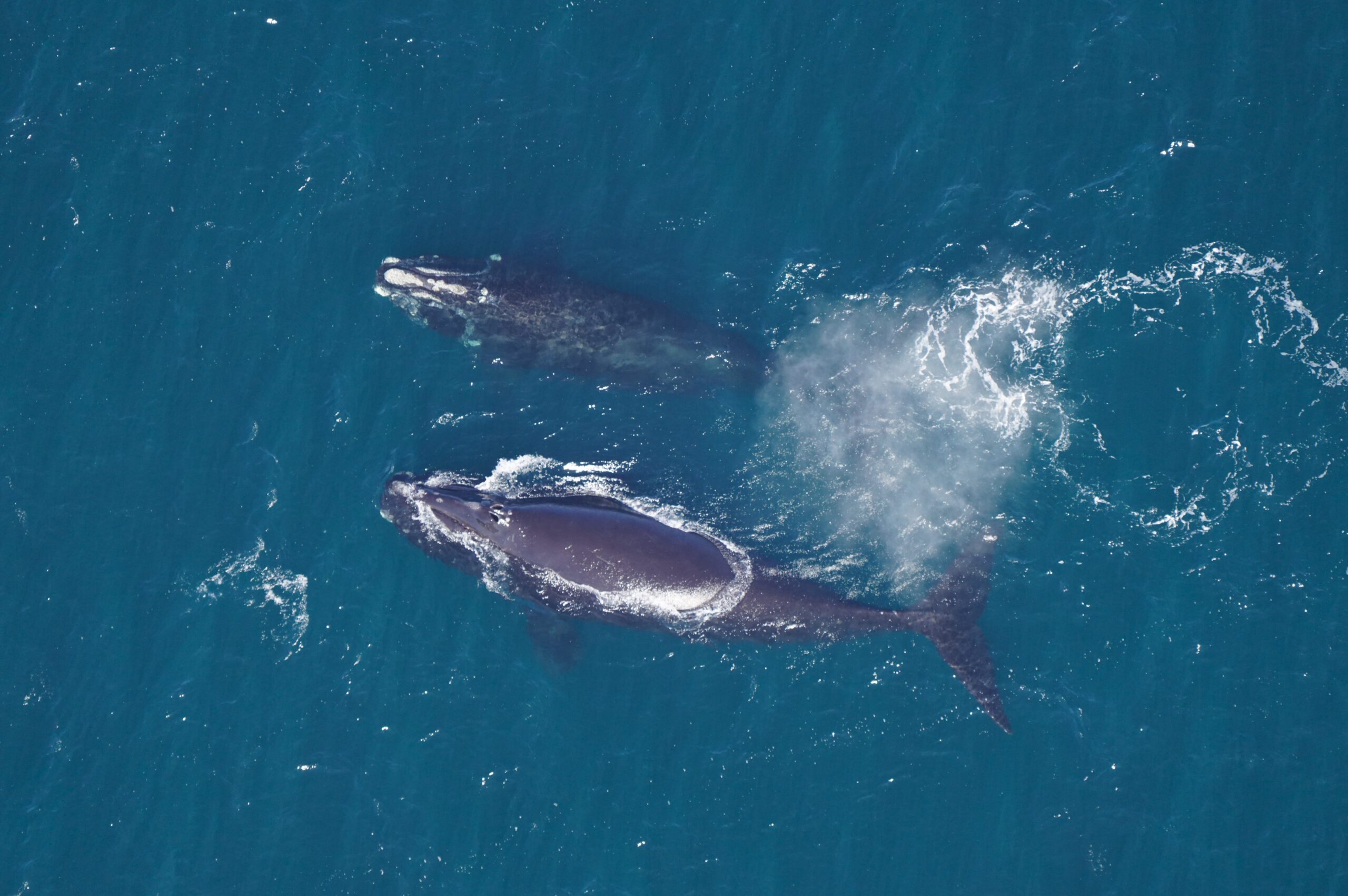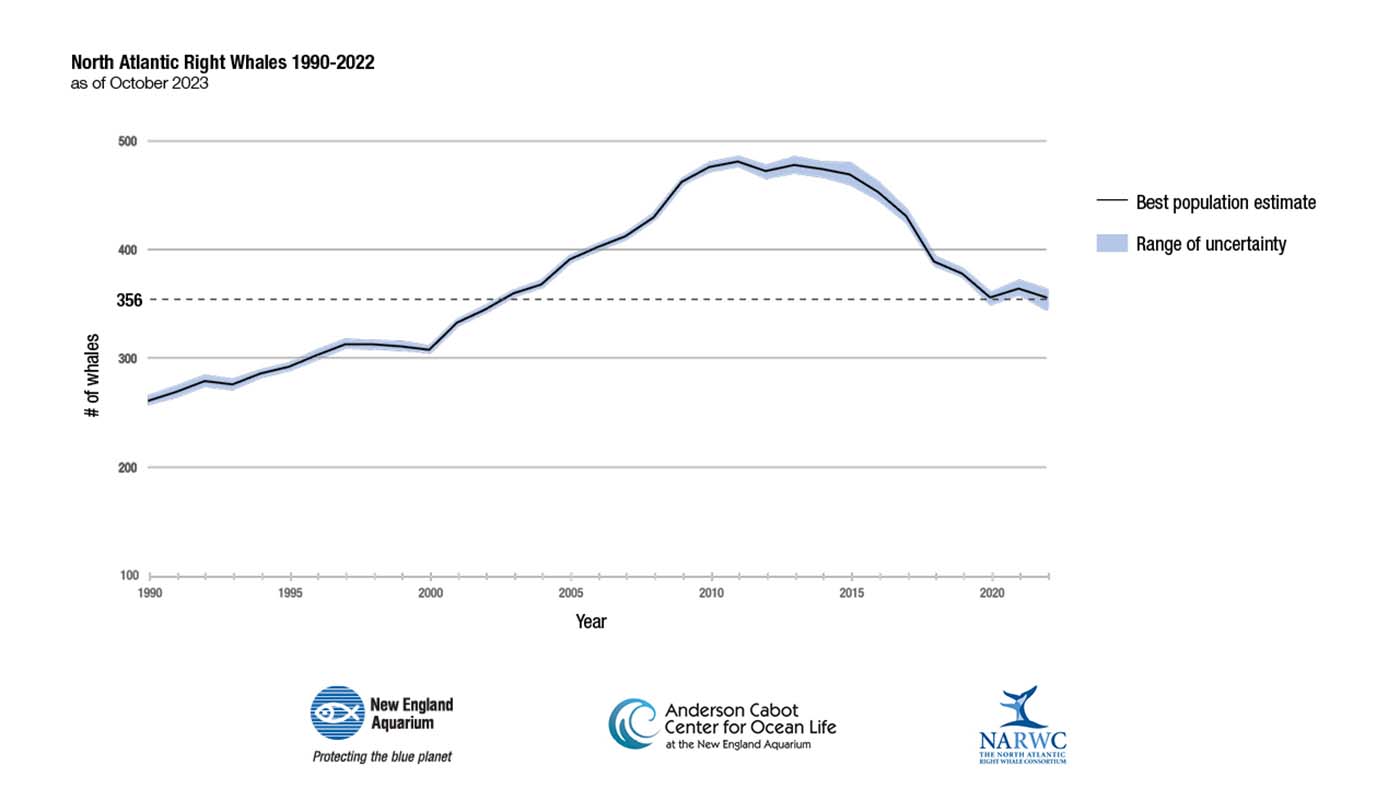Please note: We strongly recommend purchasing tickets online in advance to guarantee entry, as we do sell out on weekends.

Right whale female “Fission” (Catalog #3790) with unnamed juvenile male whale Catalog #5191 during an aerial survey over southern New England waters in March 2023. CREDIT: New England Aquarium, taken under NOAA research permit #25739
BOSTON, MASS. (Oct. 23, 2023) – After years of continued decline, the North Atlantic right whale population may be beginning to level off, though scientists emphasize that the critically endangered species still faces significant ongoing threats from human activities.
**PHOTOS AND GRAPHS AVAILABLE FOR DOWNLOAD HERE**
Each year, the North Atlantic Right Whale Consortium releases the annual population estimate for the species using the most up-to-date data, including calves added to the population since the previous year. In a report being released this week at the Consortium’s annual meeting October 24–25 in Halifax, Nova Scotia, scientists used these updated data to recalculate annual estimates of the right whale population since 1990. The 2021 estimate was recalculated as 364 (+5/-4 for range of error)—primarily due to the 18 calves born in 2021, many of which were recently catalogued—and the 2022 estimate is 356 animals (+7/-10), suggesting the downward trajectory for the species could be slowing. These estimates are the result of a collaboration among scientists from the New England Aquarium’s Anderson Cabot Center for Ocean Life and the National Oceanic and Atmospheric Administration (NOAA). (NOAA plans to post the accompanying tech memo on Oct. 23, available at this link once live.)
“While certainly more encouraging than a continued decline, the ‘flattening’ of the population estimate indicates that human activities are killing as many whales as are being born into the population, creating an untenable burden on the species,” said Heather Pettis, a research scientist in the Anderson Cabot Center for Ocean Life at the New England Aquarium and the executive administrator of the North Atlantic Right Whale Consortium.

Scientists are also sharing reports on right whale deaths, entanglements, and vessel strikes at this week’s Consortium meeting. There have been two detected deaths of right whales in 2023: a 20-year-old male struck and killed by a vessel and an orphaned newborn calf. While it is promising to have only two documented deaths, that good news is tempered by the fact that research shows roughly two thirds of North Atlantic right whale deaths go undetected. Additionally, there continue to be elevated numbers of human-caused injuries to this population. The impacts of these injuries from fishing gear entanglements and vessel strikes, the leading causes of the North Atlantic right whale’s decline, are delayed when calculating the species’ population size, scientists noted.
“Many of these injuries will likely lead to death, while other injured or sick whales may not be able to reproduce because of their condition. This is an important piece of the right whale puzzle. We can’t just focus on [detected] bodies. We must also reduce all injuries that harm this species if they are to turn the corner,” said Philip Hamilton, senior scientist at the New England Aquarium’s Anderson Cabot Center and the identification database curator for the Consortium.
To date, New England Aquarium analysis has detected 32 human-caused injuries to right whales in 2023, including six fishing gear entanglements with attached gear, 24 entanglement injuries (with no attached gear), and two vessel strikes. Efforts to protect North Atlantic right whales, one of the most endangered large whale species in the world, have involved conservationists, scientists, government agencies, and the fishing and shipping industries from both the United States and Canada. Despite these efforts, entanglements and vessel strikes continue to threaten the survival of the species and additional measures are needed. Advances in ropeless or “on-demand” fishing technology show promise, though widespread implementation will require significant financial support to escalate the manufacturing of the gear and provide training and support for the fishing industry to adopt gear use. NOAA has also been working to develop vessel speed restrictions that better protect North Atlantic right whales while ensuring both the species and economy thrive. Until the species’ numbers improve, scientists still see the need for addressing risk factors to their survival.
“We continue to injure and kill these whales at alarming rates, such that they cannot carry out basic biological functions like growth and reproduction. While the absolute population numbers are important, other indicators are discouraging. Until we implement strategies that eliminate injuries and deaths, and promote right whale health, this species will continue to struggle,” said Dr. Scott Kraus, chair of the Consortium.
Calving numbers continue to lag behind what scientists saw a decade ago. This past calving season, just 11 calves were born—fewer than the previous two years (18 in 2021 and 15 in 2022). “Pilgrim” (Catalog #4340) was the only new mother in the group, giving birth to her first calf at 10 years-old and breaking a concerning trend for female right whales to delay calving well into their adult years.
“Eleven live calves in 2023 is a very modest number and nowhere near the average of 24 per year from the 2000s. It is particularly alarming that more than 40 adult females between the age of 10 and 20 have yet to birth their first calf when the average first calving was 10 years old in previous decades,” Hamilton noted.
MEDIA CONTACT: Pam Bechtold Snyder, psnyder@neaq.org; 617-686-5068
